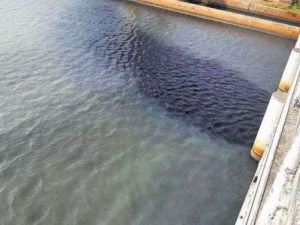Kerala’s Periyar River Is Dying an Industrial Death
Decades of toxin release into the Periyar River by the industrial area of Eloor island has turned its waters black and is now choking it to a pollutant-laid death.
Industrial pollution in Kerala’s Periyar River continues to be one of the oldest and unresolved environmental issues in the state. Decades of pollutants from industries harboured on the land of Eloor Island, located on the Periyar River, have led to a loss of water quality and devastation for its aquatic life. Over 200 industrial plants that function on the land take fresh river water and in turn disperse pollutant-laid water into the river. This has led to a gradual but continuous discoloration of the river, besides the emission of toxic gases such as sulphur dioxide, hydrogen sulphide, ammonia, and chlorine into Eloor’s air.
Decades of pollutants from industries harboured on the land of Eloor Island, located on the Periyar River, have led to a loss of water quality and devastation for its aquatic life. Over 200 industrial plants that function on the land take fresh river water and in turn disperse pollutant-laid water into the river. This has led to a gradual but continuous discoloration of the river, besides the emission of toxic gases such as sulphur dioxide, hydrogen sulphide, ammonia, and chlorine into Eloor’s air.
A Poisonous History
Located about 17 km from the city of Cochin, Kerala’s commercial capital, the Eloor island, is an industrial hub. A 450-acre industrial area was first established in 1962. It falls under the Kadungalloor panchayat. Today, the land supports Kerala’s largest industrial belt and harbours 247 chemical industries that produce chemicals, petrochemical products, pesticides, rare-earth elements, rubber processing chemicals, zinc products, fertilizers, and leather products, among others.
Most of these industries are 50 years old and have developed a process of using fresh river water, depositing concentrated effluent with nominal treatment back into the river. As per experts, this has led to large-scale devastation of aquatic organisms and local farmlands. More than 30 effluent popes spew toxins directly into the river today.
Also Read : Understanding Delhi’s Waste Management Conundrum
As per a local survey conducted by the PCB and Ward 17 Welfare Association, 13 companies, including Organo and Cee Jee, cause the heaviest amount of pollution in the river.
The Fertilizers and Chemicals Travancore Limited (FACT), Hindustan Insecticides Limited (HIL), Indian Rare Earths Limited (IRE), and Merchem Limited also topped the list.
Residents and Trauma
The Periyar River is considered to be the lifeline of South Kerala.
Two years after the industrial area was set up (in 1964), the displaced families were rehabilitated to the Thandrickal colony, near a canal that had previously been the most preferred waste dumping yard of companies previously. Close to 40 thousand people live and work on the island, and roughly 10–11 thousand of them are employed in the industries themselves. About 29 thousand community members work elsewhere. There is a high direct and indirect dependence on industries for a large part of the community.
Studies also point to the presence of pesticides and heavy metal residues in the vegetables, fruits, and poultry grown on local farms in Eloor, which, when consumed, are harmful to human health. “The people of Eloor are under trauma as the deaths due to chronic diseases continue,” environmental justice portal EJ Atlas reports.
The environmental impact of industrialization over the river has led to air pollution, loss of biodiversity, crop damage, loss of landscape (aesthetic degradation), contamination of soil, and surface water pollution. It has also disturbed the hydrological and geological ecosystem of the river. In the health perimeter, villagers have witnessed radiation, occupational diseases, and have undergone accidents due to the machinery.
Also Read : The River Interlinking Project: A Solution for India’s Water Crisis?
Resistance
While the Kerala High Court, based on a petition filed in June 2012, had suggested stopping the construction of polluting industries, not much seems to have changed.
The river has also seen a periodic decolouration due to environmental pollution in the Eloor-Edayar belt. The river takes up many colours due to the wide variety of chemicals released into it. In April 2020, for the first time ever, the river turned black. Experts say that this discoloration is caused primarily due to the release of untreated and partially treated effluents.
In 2020, the State Pollution Control Board kick-started a study to analyse the sources of pollution in the river after a stringent directive from National Green Tribunal’s southern belt to restore the river to its original state. The study was scheduled to be done in 3 phases and the final report was to be submitted in January 2021. However, it has taken a backseat due to the pandemic.
There has been high resistance from the people against the industries, including widespread protests, mass movements, and arrests. International and local groups have also joined together to save the river. Local communities, however, have been protesting for over a decade, which has highlighted the issue of industrialization, while also legitimizing it. Organizations such as the Periyar Malineekarana Virudha Samithi, Collective for Right to Live, and Greenpeace have been actively involved in the battle for a cleaner Periyar River.
Greenpeace India has suggested the following remedial measures: Zero industrial discharge over the Periyar, clean production in industries, compensation and medical rehabilitation of pollution-affected citizens, clean-up of contamination sites, vigilant enforcement of environmental laws, etc.
(Parts of this article were taken from EJAtlas)
